
Zendesk CX Trends 2026 – From industry insight to Zendesk in practice
Zendesk’s 2026 CX Trends reveal where customer experience is heading. This article makes those trends practical, showing how to apply memory-rich AI, instant resolutions, multimodal support, analytics and transparency directly in Zendesk using what’s available today.
Zendesk has released its 2026 CX Trends report. Based on insights from thousands of customers and CX leaders, it highlights how customer and employee service are evolving, and where the industry is heading.
Each year, the report brings five core trends, along with context and guidance on how they shape your approach to customer service. But reading trends is one thing. Applying them to your own organisation is another. It’s not always clear where to start, or whether your current setup can support the shift.
This article translates those insights into practical steps you can implement in Zendesk today. And in areas where the platform is still evolving, we’ll explain how Zendesk is closing the gaps, so you can plan with confidence.
Introduction
Looking back at the last two years, you can see how quickly AI maturity has accelerated. The 2024 report focused on getting AI in place, improving collaboration, and ensuring more personal responses. By 2025, the focus had already shifted towards autonomous agents, voice, and increasingly dynamic interactions.
The 2026 trends reflect a more grounded maturity. Since the rise of LLMs, we’ve all experienced the gap between the promise of AI that truly understands us, and the reality of weak implementations, inflated expectations, or a lack of trust.
Yet underneath it all, the core needs haven’t changed: personalisation, insight, and trust still matter, even as we move into a more automated, agentic world.
The five trends for 2026

- Memory-rich AI is fuelling personalisation
- Customers demand instant resolutions
- Multi-modal support is redefining consistency
- Promptable analytics unlocks better insights
- AI transparency is more important to customers
Before we explore how to activate these trends in Zendesk, it’s worth highlighting the common thread that runs through all of them: knowledge, use cases, and data.
To personalise a conversation, you need to know who the customer is and why they’re reaching out. To deliver instant resolutions, you need documented processes and clear instructions. Analytics only work if they understand your customers, your workflows, and your outcome data. And transparency is only meaningful when you can clearly show where information comes from, and how decisions were made.
It all comes back to knowledge, use cases, and data.

Memory-rich AI is fueling personalisation
Trend 1
CX organisations invest in memory-rich AI to deliver true personalisation at scale.
This trend builds on previous years’ focus on personalised support but expands it beyond recognising who the customer is. Memory-rich AI adds a deeper layer: it takes account of a customer’s past interactions, promises made, actions taken, and context across channels, and uses that history to make every conversation feel relevant and informed.
Zendesk is not yet a true memory-rich AI platform. Today, most AI-driven interactions treat each ticket as a standalone moment. Your AI Agent doesn’t automatically know that the customer asked about the same issue yesterday, or that they were promised a delivery date. That historical context only becomes visible when you move up to the agent or admin layers.
However, that doesn't mean memory is out of reach. We can already use existing features to simulate a form of contextual awareness. Here’s where Zendesk is quietly laying the groundwork.
Memory-rich AI is technology that retains and applies relevant details from every prior interaction across channels, as well as what you’ve learned about your customers over time.
Using recent data to personalise greetings
Imagine a customer visiting your theme park website. They booked tickets two days ago, or they’re about to visit next week. Instead of greeting them with a generic “How can I help?”, your AI Agent could retrieve that order, acknowledge the booking, and offer tailored help, before they even start asking questions.
Using API Actions and procedures in AI Agent Advanced, we can pass authenticated customer data into the greeting. Suddenly the experience becomes contextual, practical, and human.
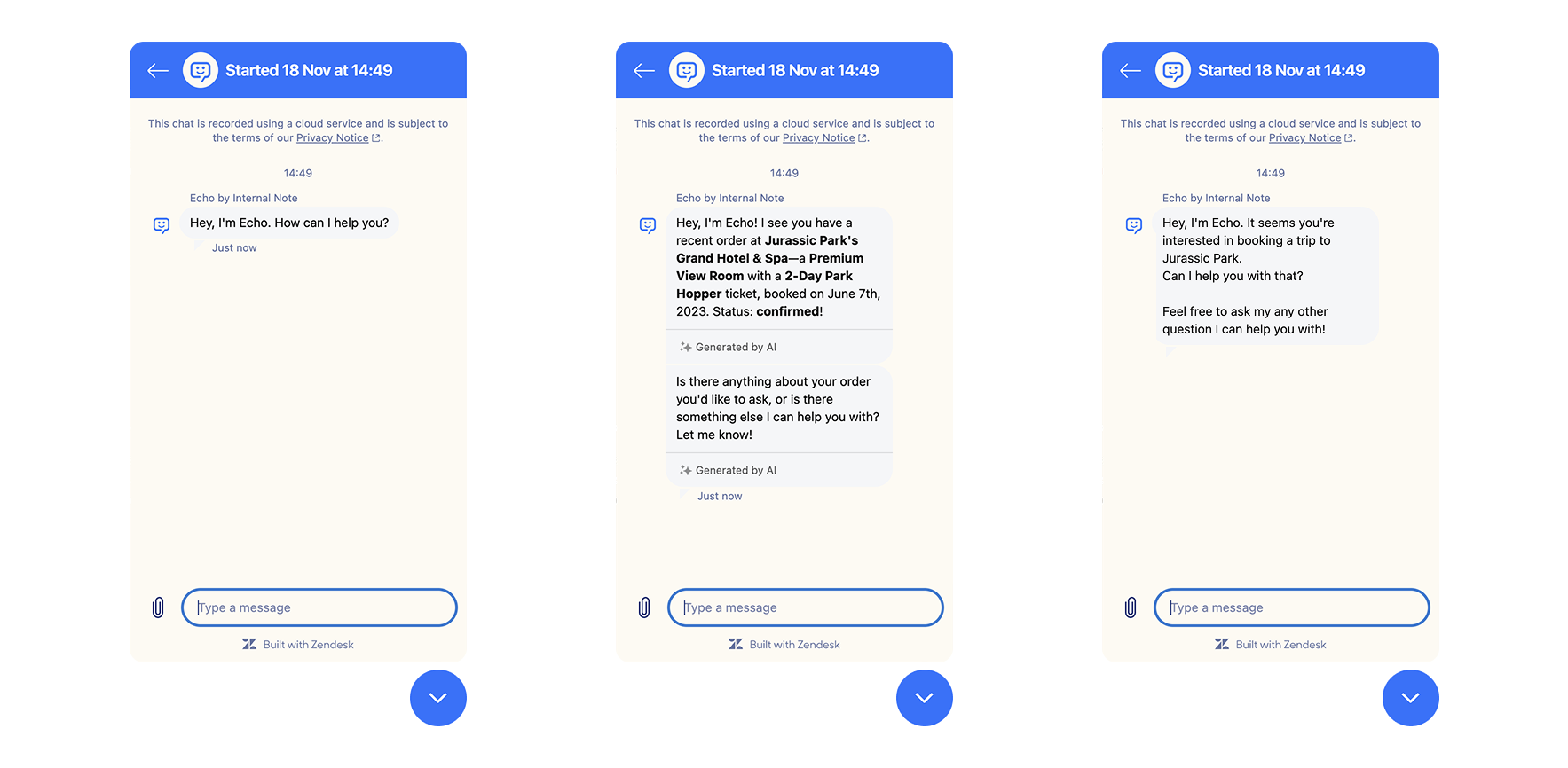
We can do the same with browsing behaviour. By passing the current URL or page title into the conversation, the agent can adjust its greeting based on what the customer is actually looking at — perhaps a returns policy, billing FAQ, or upgrade page.
<script>
zE(function() {
// Set both the current URL and the Page Title as conversation fields
zE('messenger:set', 'conversationFields', [
{
id: '1111111111', // REPLACE with your URL custom field ID
value: window.location.href
},
{
id: '2222222222', // REPLACE with your Page Title custom field ID
value: document.title
}
]);
});
</script>Sample script to pass content to AIAA
Simulating memory using Agent Copilot and APIs
Real memory-rich AI doesn’t just scan the current request. It understands what happened before. If a customer was promised delivery by Thanksgiving, and they return the next day because it hasn’t arrived, the agent should already know that. It should be able to acknowledge the promise, apologise, and move directly into remediation, without the customer having to start from scratch.
Zendesk’s AI Agents don’t yet maintain that conversational memory across interactions. Each conversation is still handled as a standalone moment. However, we can already simulate parts of this using Agent Copilot summaries, APIs, and procedures.
Before starting a new interaction, we can call the Zendesk API to retrieve recent tickets for that customer, analyse them using Copilot summaries, and surface key context such as delivery dates, previous complaints, or order status updates. That context can then be embedded into the greeting.
Instead of saying: “Hello, how can I help?”, you could say: “Hi Sarah, I can see you contacted us last week about your missing order. Has it arrived yet, or would you like an update?”
We can’t fully resolve the issue based on historical memory yet, but we can begin the conversation in a way that acknowledges what the customer has already been through. It reduces friction, increases trust, and gives the experience a sense of continuity.
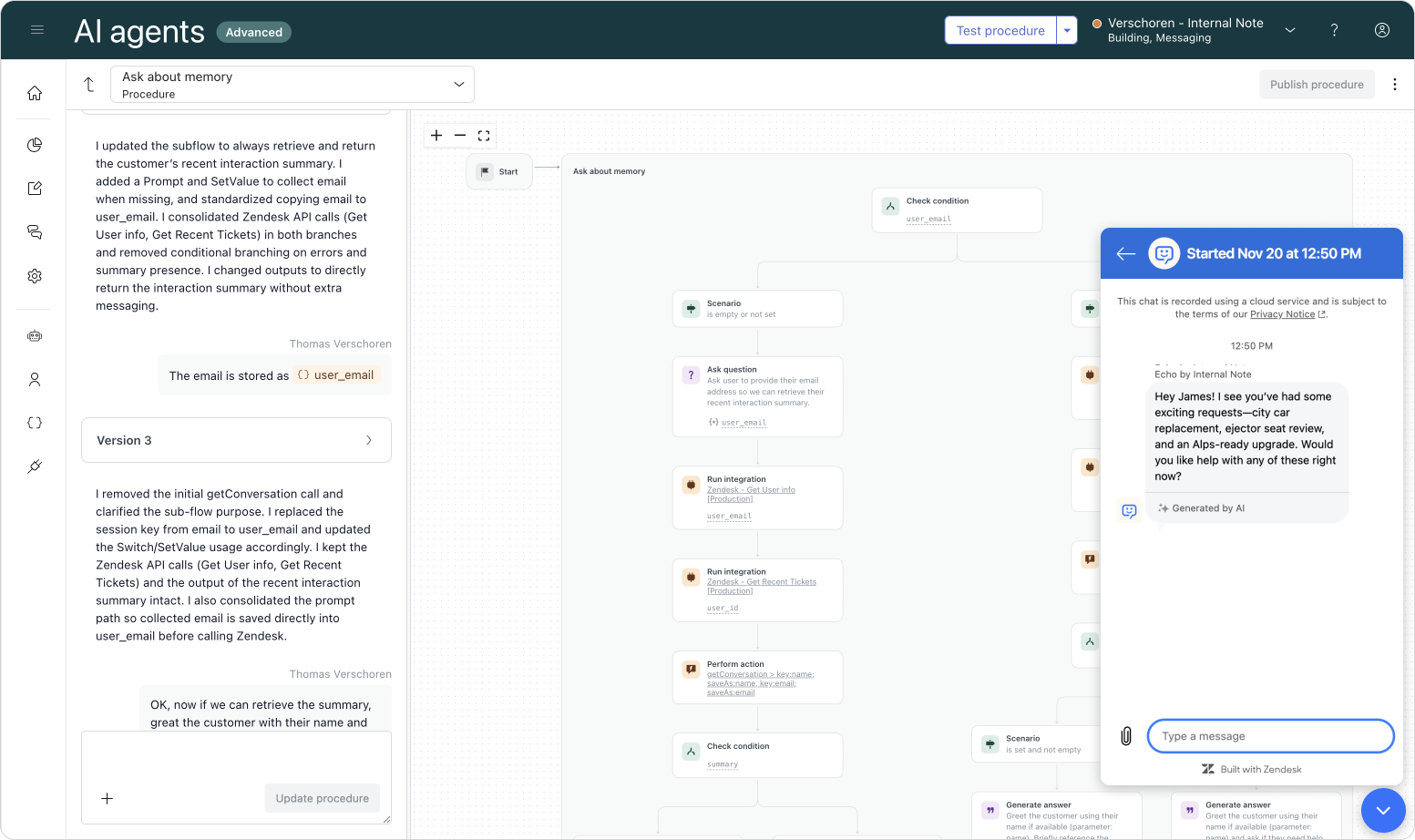
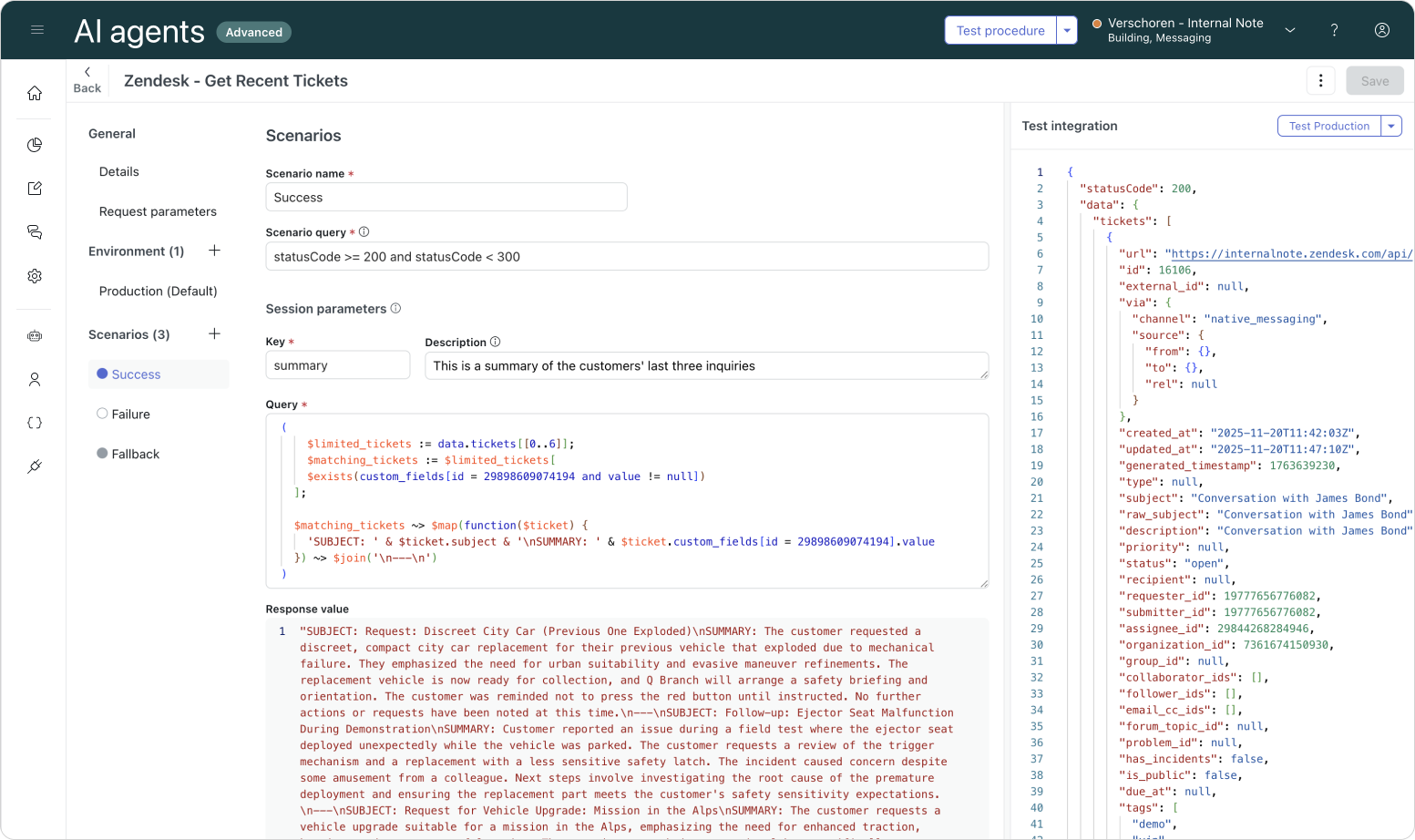
Leveraging Agent Copilot summaries and the Zendesk API to offer a personalised greeting based on past interactions.
Memory shows up differently at each layer
Although AI Agents don’t yet retain true memory, different layers of the Zendesk platform are already using past interactions in meaningful ways, just not always visibly.
At the agent layer, Zendesk begins to surface historical context. Merge suggestions automatically identify related tickets or previous conversations with the same customer, even if they took place on a different channel. If a customer shares photos in a follow-up email after reporting damage through chat, those separate interactions are identified and surfaced to the agent, making it easy to merge or reference them. Procedures can also pull data such as order history, customer identifiers or product registrations from the user profile, and feed that context directly into actions.
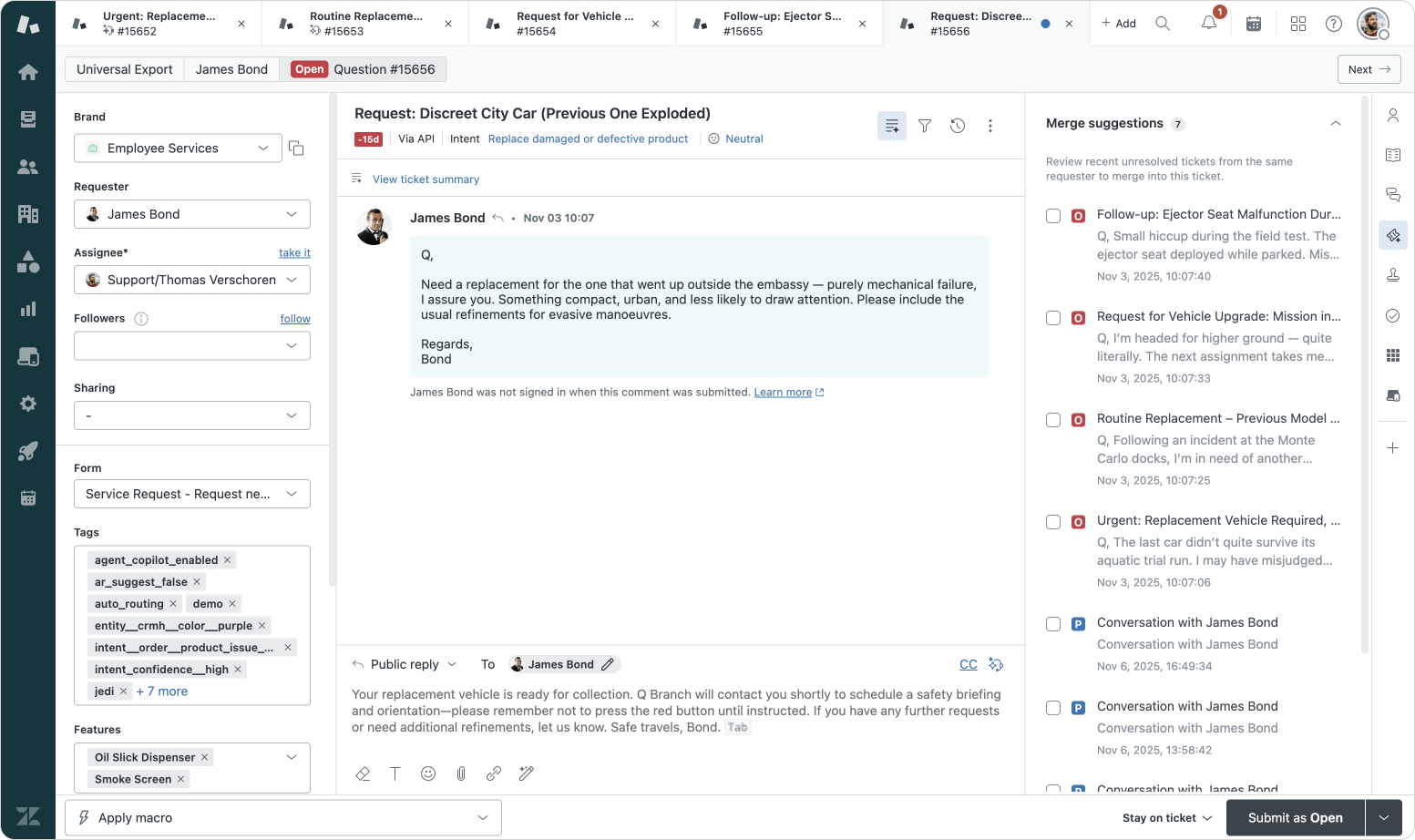
At the admin layer, context shifts from the individual to the aggregate. Agent Copilot now offers more than twenty recommendation types that analyse patterns across your entire conversation history — not just single tickets. It identifies trends, surfaces new potential intents, and highlights areas where procedures, triggers or flows could be improved. Rather than personalising an interaction for one customer, it helps improve your overall capability to deliver consistent, relevant experiences at scale.
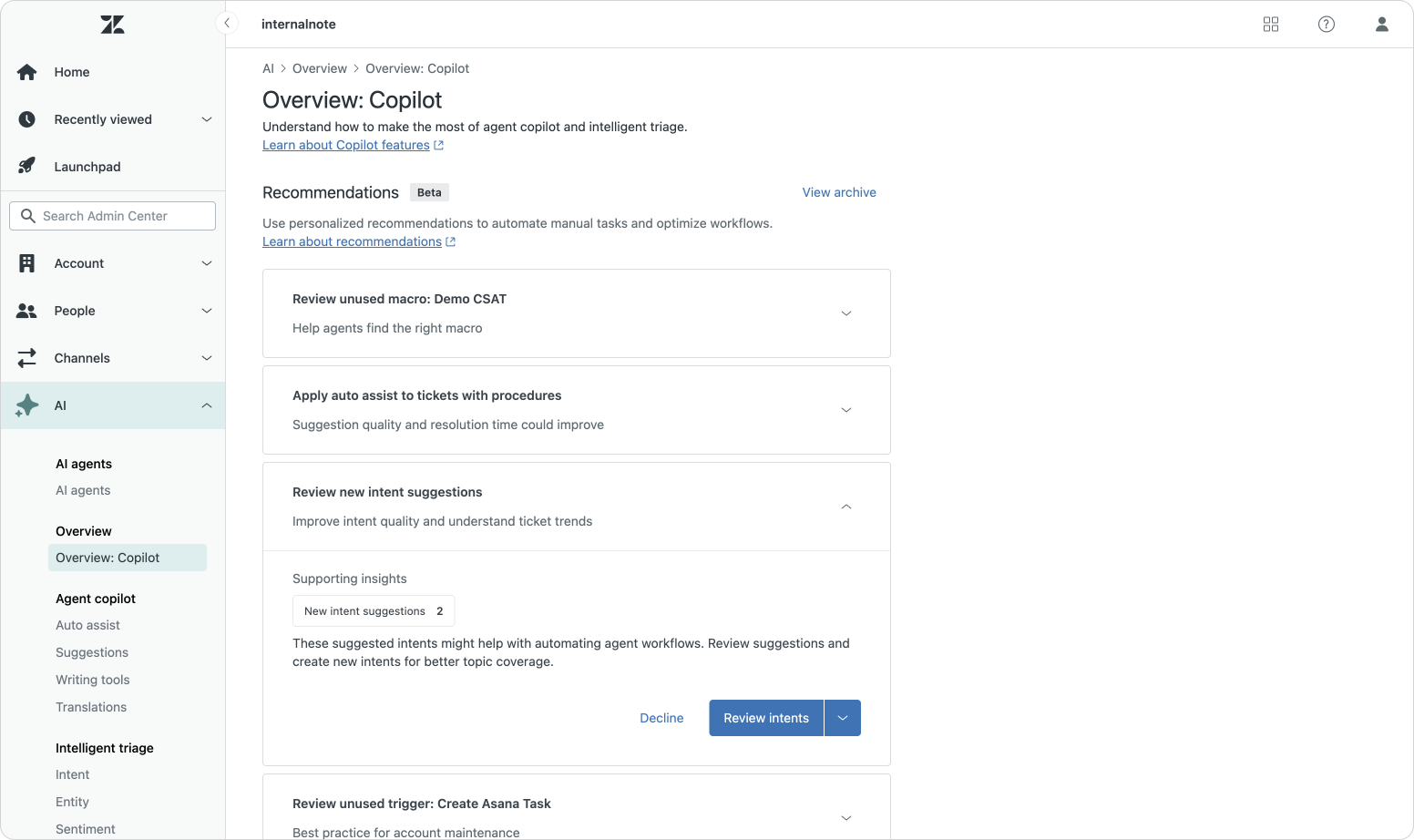
And then there’s the analytics layer. AutoQA, intent detection, knowledge suggestions and Knowledge Builder all rely on cross-conversation insight. They don’t look at tickets one by one, they look at clusters, themes and behaviours over time. These features are already thinking in sequences. They see the whole picture, even if your AI Agent cannot yet do that in a live interaction.
Taken together, these layers show where Zendesk is heading. Memory is already informing the system. It just hasn’t fully reached the customer-facing parts yet. But the foundations are already there.

Customers demand instant resolutions
Trend 2
AI-powered self-service accelerates consumer demand for instant resolutions.
Customer expectations don’t shift overnight, but once they do, there’s rarely any going back. When Amazon made next-day delivery free and predictable, every other delivery suddenly felt slow, inconvenient, and outdated. Netflix did the same to weekly TV releases. Once people became used to instant access, waiting a week felt unnecessary and frustrating.
AI is doing the same to customer service.
As people grow used to getting answers instantly, from voice assistants, generative chat tools, or embedded AI in their favourite apps, their tolerance for delays drops sharply. Being available 24/7 is no longer enough. People now expect to get answers, explanations, and even resolutions, instantly. This is where AI-powered self-service becomes central to your setup.
Why instant expectations change how we measure success
Zendesk already supports instant, automated replies through Quick Answers in the Help Center and AI Agents across messaging, email, and soon voice.
Quick Answers replace the traditional search result list with a direct, concise response.
AI Agents apply that same content in live conversations, enriched with data from Federated Search, web crawlers and connected knowledge sources like Confluence.
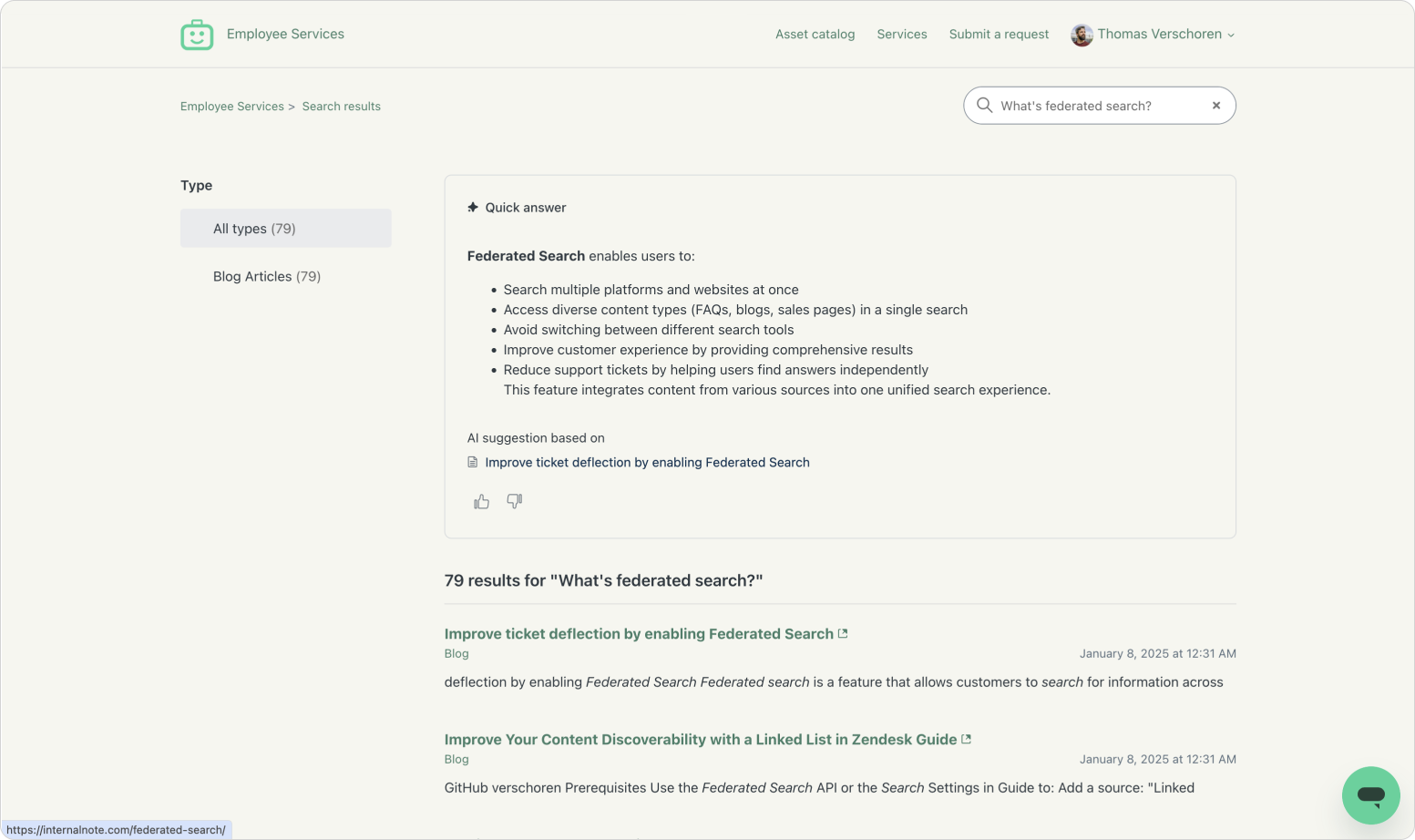
From answering questions to completing tasks
If you've read Road to Automation or Moving towards value-driven conversations, you already know that knowledge alone rarely resolves a full request.There's questions about refunds, rescheduling, cancellations, subscriptions, onboarding. They require logic, validation, eligibility checks or multi-step processes. That’s when you move beyond answers and into resolutions.
Round-the-clock support is now table stakes. Get ahead of customer expectations by deploying AI agents powered by connected knowledge that can retrieve and apply the right information, fast—whether for simple FAQs or more complex, multi-step issues.

That’s where use cases, procedures, and actions come into play in AI Agents Advanced. Here, you can define structured workflows that allow the AI Agent to gather context, call APIs, access systems, and complete tasks and pass the results to the customer. The agent can either complete the request fully, or act as a concierge by collecting the right information and routing it to the right team.
As procedures evolve, they begin to handle more of the resolution themselves, not just the intake. The more of your common use cases that are fully defined, the more of your interactions shift from “waiting for help” to “immediate resolution”.
Instant resolutions are the new response time.
This shift also changes how we measure success. When responses start arriving instantly, traditional metrics like first reply time lose their meaning. Instead, the more relevant metric becomes resolution success, the moment where the customer’s problem is actually solved.

Multi-modal support is redefining consistency
Trend 3
Multimodal support enables seamless interactions across different channels and media.
Zendesk has always been an omnichannel platform. Customers can contact you over messaging, email, voice or social channels, and in many cases continue the same conversation even if they switch channels. Someone who starts in the Messenger widget can later pick up the conversation in WhatsApp, or receive the reply by email if they’ve left the browser. Even voice calls are part of the same ticket, allowing agents to reply with a follow-up email, links or instructions without leaving the flow.
That flexibility has long been one of the strengths of Zendesk: the channel may change, but the context remains.
Multimodal support takes that foundation further. It doesn’t just allow people to switch channels, it lets them change how they communicate: typing, speaking, showing, sharing an image, or demonstrating a problem with their camera or screen. Instead of choosing the right channel, customers simply choose the most natural way to explain their issue. They expect the agent (or AI Agent) to adapt.
Multimodal support enables customers to communicate using voice, images, video, and text in a single, fluid interaction to help get the right resolution.
From switching channels to switching formats
Zendesk’s upcoming video calling and screen-sharing capabilities are a clear example. If a customer is better served by showing you the broken device, the agent can switch to video. If they’re struggling to follow instructions, they can share their screen instead. The medium changes, but the interaction continues seamlessly.
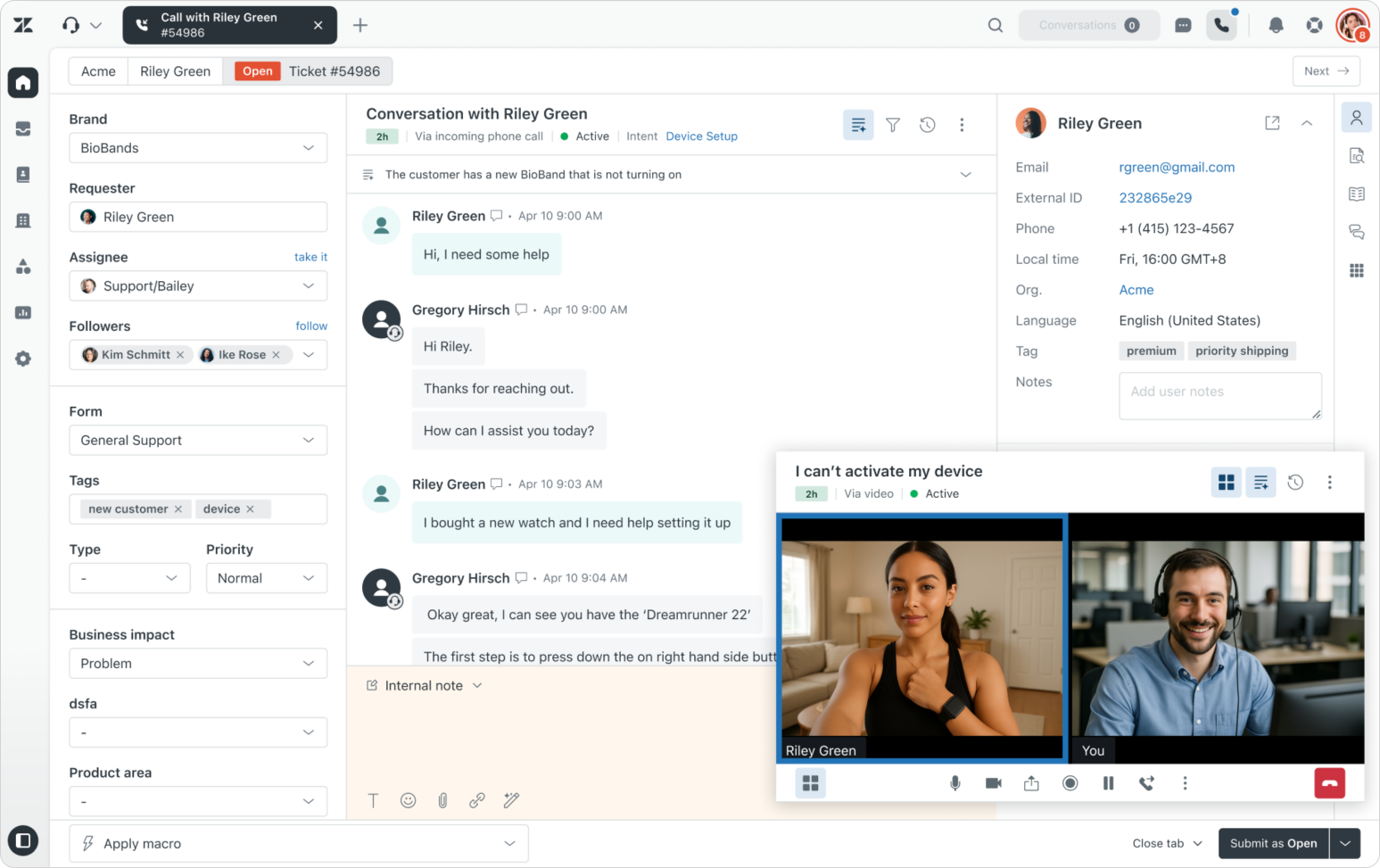
The same happens on mobile. Using the built-in attachment options in the web widget, customers can take a photo or upload a document directly into the conversation, without leaving the flow. That image can then be analysed by leveraging Marketplace apps to help resolve the issue faster.
Multimodal isn’t just for customers
Multimodal doesn’t only benefit the customer. In the agent experience, Zendesk is beginning to blend voice, text and procedural guidance in real time. Speech is transcribed instantly, intent detection updates as the customer speaks, and Agent Copilot dynamically surfaces relevant procedures and steps. All while the agent stays in conversation. It helps the agent focus less on searching for the right answer, and more on confirming and delivering it.
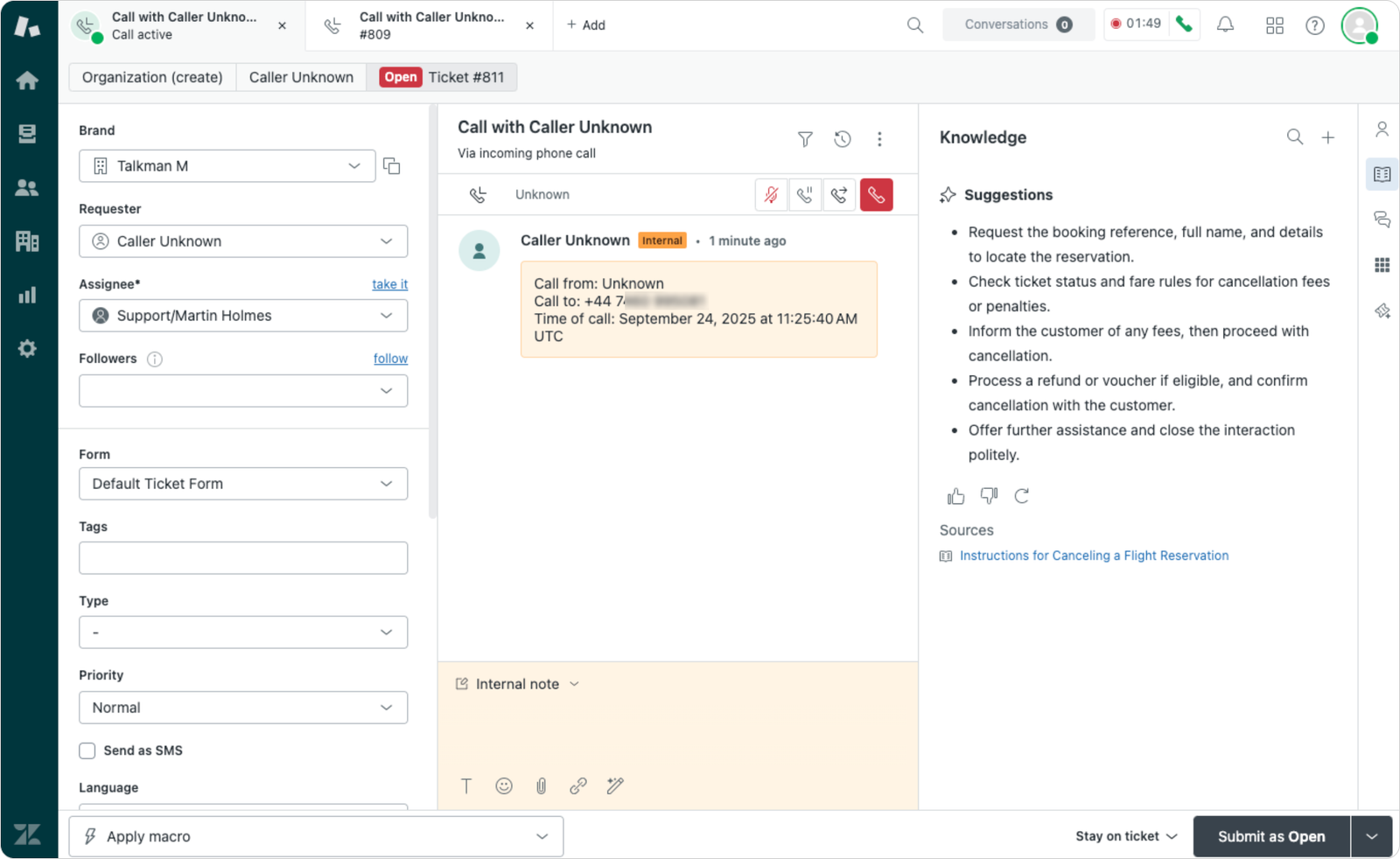
As AI Agents, Voice AI, and the messaging experience evolve, these interactions will become even more fluid. Multimodal support moves customer service beyond channels. It lets people communicate the way humans naturally do, by speaking, showing, sharing or asking — and expects the system to keep up.

Promptable analytics unlocks better insights
Trend 4
CX leaders rely on new AI metrics and access them via prompt-driven analytics.
Reporting is often one of the hardest parts of customer operations, not because the data isn’t there, but because turning it into decisions requires three separate things: structured data, the ability to query it, and a clear idea of what to measure.
To get there, you first need rich, well-structured data. Traditionally, that meant asking agents to rigorously tag tickets so that you could later filter and categorise them. Then you needed someone who knew how to build reports: constructing calculated attributes, filters and metrics. Finally, you needed leaders who knew which questions to ask, and which hidden patterns might be missing from the dashboard.
That combination is fragile. It is easy to end up with incomplete tagging, complex reports that only one person understands, and metrics that describe what happened without explaining why.
AI-powered analytics are designed to break that deadlock.
From collecting data to understanding it
Zendesk starts by using intelligent triage to enrich every conversation with intent, sentiment and entity detection. AutoQA adds another layer, evaluating how tickets are handled and how resolutions are delivered. Together, they turn unstructured conversations into structured, queryable data. And that without adding extra work for agents, it mostly removes that work almost entirely.
The second barrier, knowing how to build reports, is addressed through Quick Reports. Instead of writing calculated attributes and case statements, you describe what you need in plain language and let Zendesk build the report. Previously, something as simple as grouping products into bands might have required an expression like:
IF VALUE([Product code])>500 THEN ">500"
ELIF VALUE([Product code])<=500 AND VALUE([Product code])>300 THEN "300-500"
ELSE "0-300"
ENDIFExample of a query that groups products based on their product code
With Quick Reports, you can simply ask: “Group products into 0–300, 300–500 and >500 based on product code, and show ticket volume and CSAT for each group.” The system generates the logic for you, and you refine it with follow-up prompts.
Quick Reports
The third barrier is understanding what the numbers actually mean. Zendesk’s HyperArc acquisition is aimed at that layer. Instead of just surfacing charts, it helps interpret them: adding narrative context, historical comparisons, and explanations of why certain patterns appear. It moves teams from passively reviewing dashboards to actively understanding their data.
Promptable analytics pair real-time, natural-language insights with AI performance metrics to give CX organisations on-demand, context-aware analysis.
Bringing insight, action and optimisation into one loop
Analytics traditionally tells you what happened. AI focused-dashboards and Admin Copilot goes further by showing how well your automation is performing. It surfaces where AI Agents and Copilot succeeded, where they were overruled by humans, which procedures led to poor experiences, and where customers escalated because the flow didn’t quite fit their situation. You can see where automations are effective, and where they quietly fail.
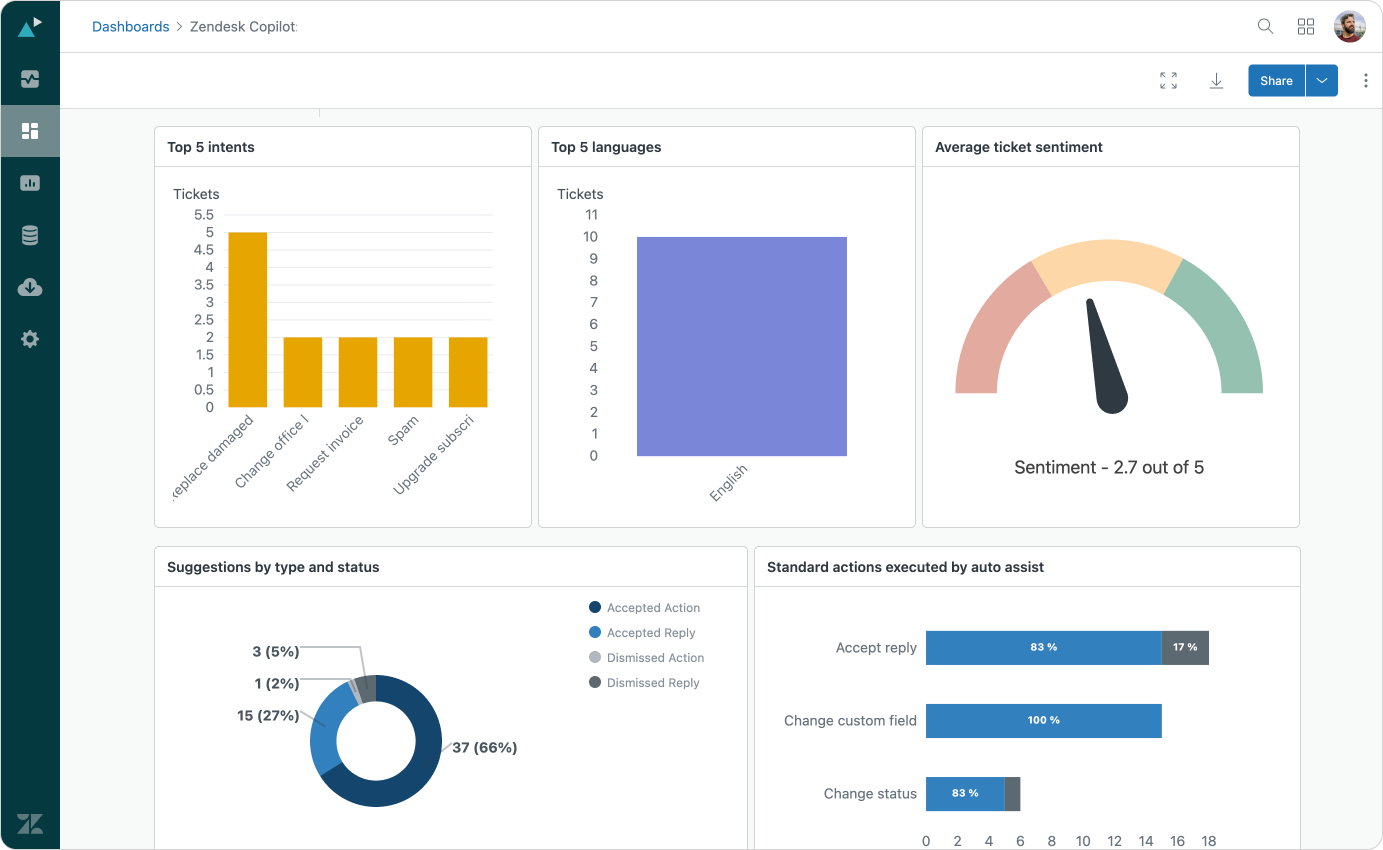
That context matters, because it highlights both opportunity and risk. An AI Agent may successfully handle refunds in most cases, but consistently fail when orders are older than seven days. A procedure might perform well until it encounters international shipping. These gaps aren’t obvious unless your system exposes not just results, but why certain branches succeeded or failed, and what to do about it.

This is where Admin Copilot begins to connect the dots. Instead of manually tracking down the trigger, trigger or automation responsible, you can simply describe the issue to the system. Admin Copilot will surface the relevant configuration, the missing automation and tags, the trigger that is routing incorrectly, or the queue that is misaligned, and help adjust it. You don’t need to search for the setting. You describe the behaviour you want, and the platform shows you where to apply it.
Over time, these two parts, AI focused-reporting and Admin Copilot, start to form the core of a continuous feedback loop.
Your conversations feed analysis, analysis identifies where automation is working (or not), and Admin Copilot helps apply the change directly to your workflows.
That makes configuration less of a project and more of a practice. Instead of reviewing analytics once a quarter, you adjust and optimise as issues appear. All based on actual behaviour, real customer outcomes, and clear reasoning.
Promptable analytics is not just reporting. It is how insight, context, and configuration start to work together.

AI transparency is more important to customers
Trend 5
More than ever, consumers demand the why behind AI decisions.
AI can provide answers, but customers now expect something more: they want to understand why a certain answer was given. Trust in AI doesn’t just depend on accuracy, it depends on clarity. People want to know where the information comes from, and why certain decisions or outcomes are applied to them.
You can't afford the luxury of being anything less than perfect. If you do, they lose faith, and you lose command - Spock
With traditional search, users naturally expect to see citations, authors, dates and links. But when that information is embedded into a generative reply, people feel uneasy unless that same transparency is present. They’re not just questioning what is being said, they’re questioning why it’s being said at all, and whether it should be trusted. They want to know where the answer comes from.
Zendesk AI Agents differ from general-purpose AI because they only pull from verified sources related to the brand a customer is visiting: your help center content, indexed sources, or pre-approved systems. That gives the advantage of controlled accuracy, but accuracy alone isn’t enough. You still need to show customers where the answer came from, how it was derived, and why it applies to this moment in their request.
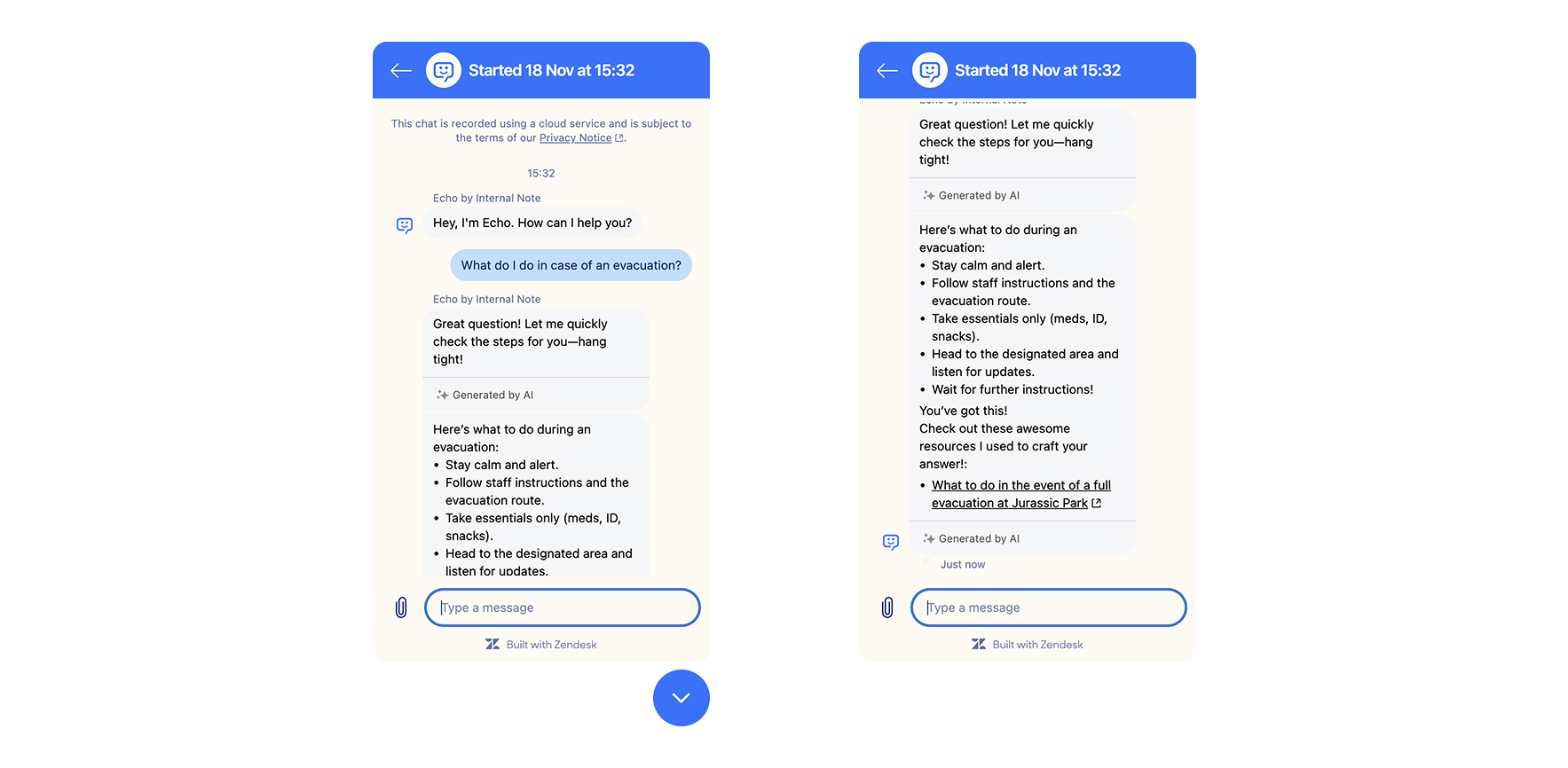
That’s where source attribution, inline references and generated context all contribute to trust. Customers can independently verify that the answer aligns with what the full article, policy or system says.
Transparency becomes even more important when the AI Agent isn't just answering but making decisions. If a customer’s cancellation request is denied, “computer says no” is not a valid resolution. The answer needs context:
“No — because the order is older than seven days.”
“No — the package has already shipped.”
“No — the return window has expired.”

These explanations don’t just remove friction. They preserve trust, even when the outcome isn’t what the customer wanted.
Transparency fuels continuous improvement
Transparency is not just for customers. It fuels improvement on the backend too.
In AI Agents Advanced, conversation logs show how the system interpreted each message, which branch of the procedure it followed, what API returned which data, and ultimately why it produced that answer. You can see where the logic held up and where it didn’t.
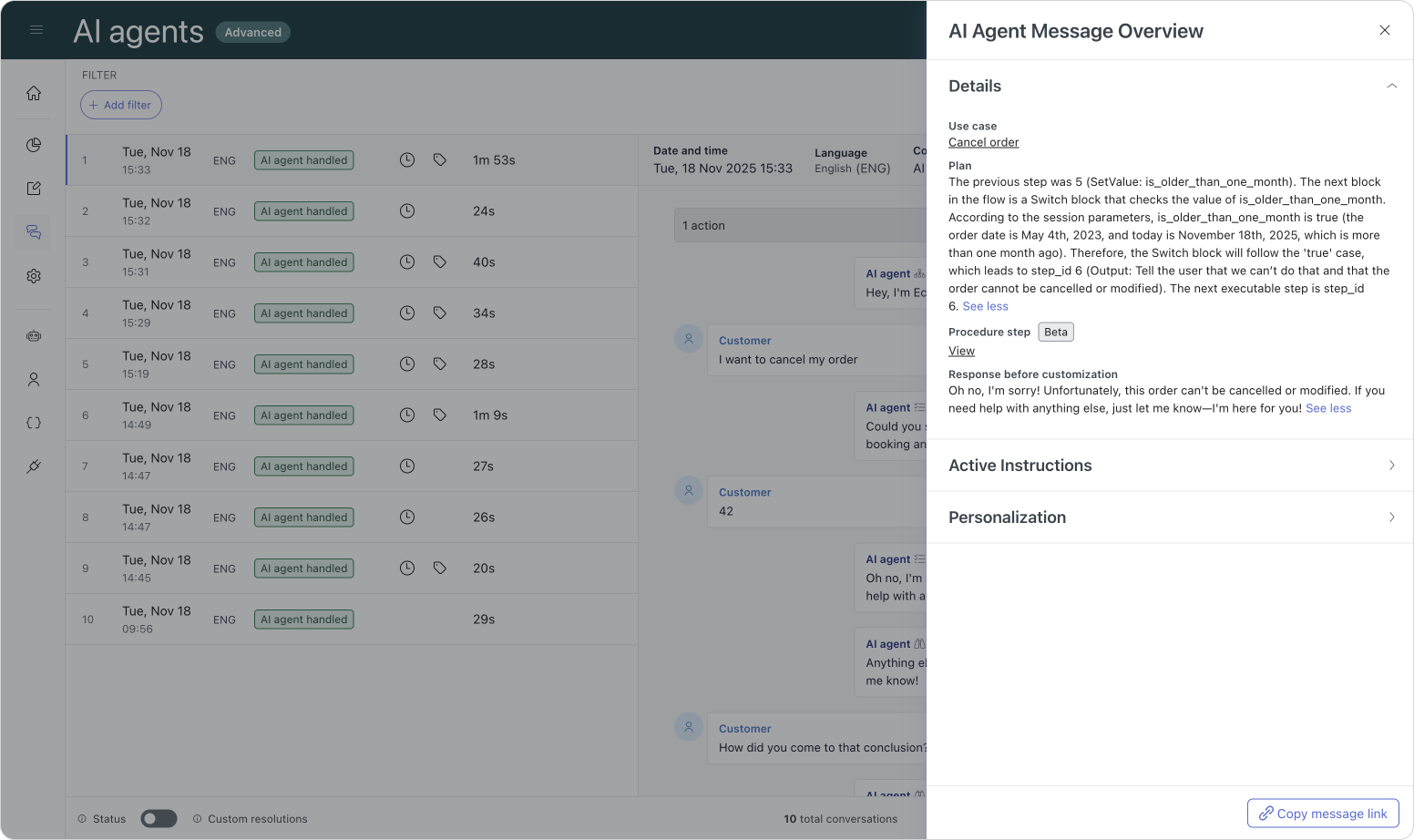
Then comes the feedback loop:

- You identify where a conversation went wrong: a misunderstanding, a missing rule, or poor eligibility handling.
- You inspect the reasoning trail to understand why it happened.
- You fix it: refine the procedure, update the API action, or add a missing exception.
- You monitor performance and see whether the change improves future resolutions.
- The system starts surfacing further opportunities — repetitive handovers, common edge cases, or frequent overrides — helping you take the next step in optimisation.
This loop connects customer experience, agent feedback, AI performance, and Admin Copilot configuration. Transparency makes problems visible. AI Insights surfaces patterns. Admin Copilot helps you apply the fix. Then the process starts again.
Transparency is also for agents, not just customers
In Agent Copilot, every AI-assisted suggestion now includes a reasoning view. Agents can inspect why the system drafted a suggested reply, what data it used, or which procedure triggered it. If it’s wrong, Agents don’t simply overrule it, they can send feedback. That feedback then feeds back into the optimisation layer, helping you improve responses for the next customer and the next agent.
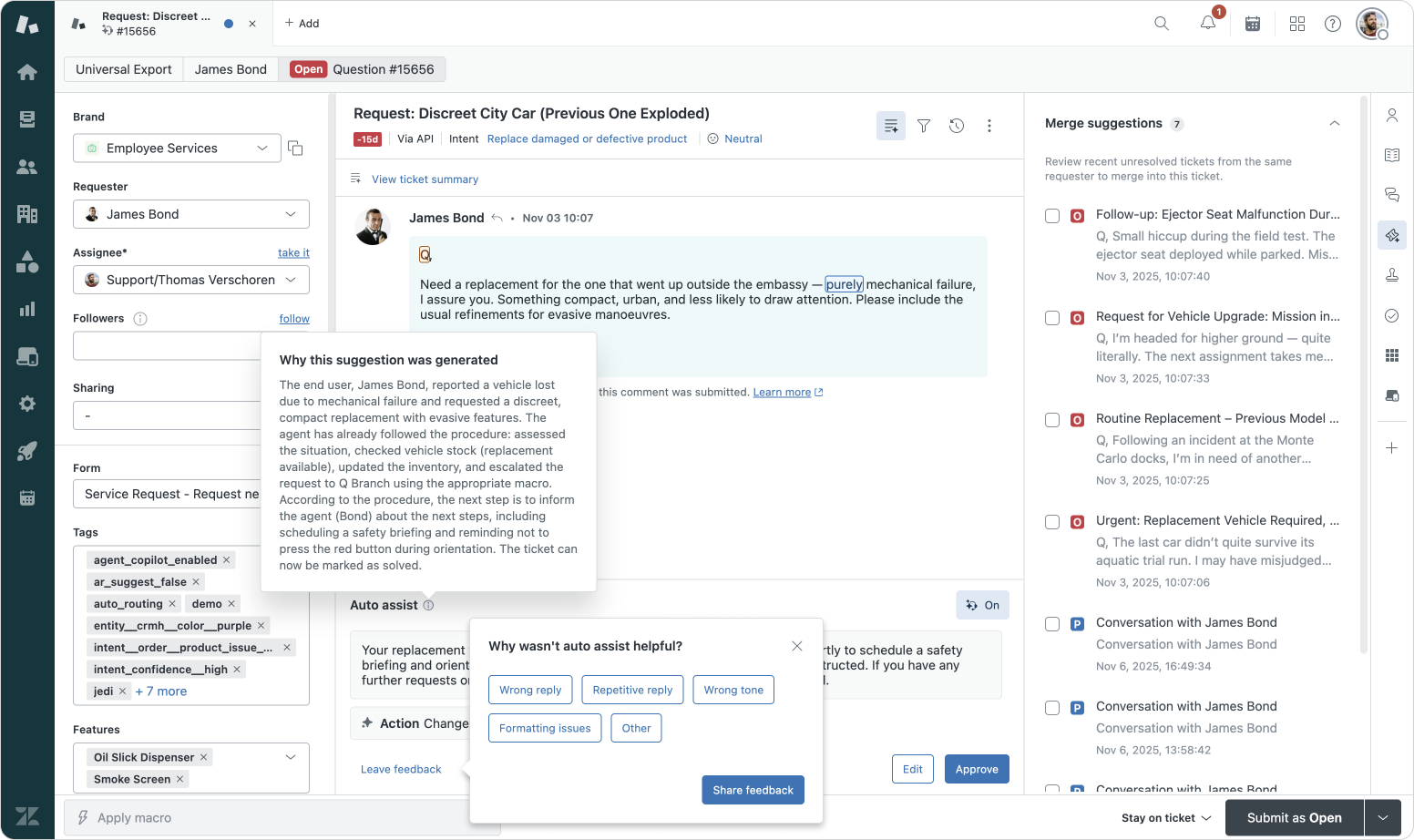
In short, transparency creates accountability for customers, clarity for agents, and improvement for admins.
True AI trust doesn’t come from perfection. It comes from visibility, explanation, and the ability to improve the system , one learning at a time.
Set the new standard of excellence in CX
Zendesk’s CX Trends report shows that the organisations delivering the most effective experiences are not simply adding AI to existing processes. They are steadily building contextual intelligence across their entire operations, powered by knowledge, use cases, and data.
We’ve seen how memory-rich AI moves beyond personalisation and begins to build continuity. We’ve seen how AI-powered automation shifts expectations from waiting for answers to achieving resolutions instantly. We’ve seen how multimodal conversations move beyond channels to let customers communicate however they naturally need to, showing, speaking or sharing. We’ve explored how promptable analytics changes reporting from something you review to something you act on. And we’ve seen how transparency is not just a compliance measure, but a trust, governance and learning engine, feeding a continuous cycle of identify, explain, improve.

All of these trends point in the same direction: AI is no longer something we add. It becomes the fabric that connects every conversation, workflow, decision and recommendation across your CX environment.
But you don’t get there by building everything at once. AI transformation happens one use case at a time. Start small. Automate what’s repeatable. Bring in context. Add trust. Then expand. Each successful interaction becomes the foundation for the next.
That’s not just the approach. It’s the competitive advantage.
Set the new standard of excellence in CX
High-maturity organisations are outpacing their peers in every arena—bolstering their CX with contextual intelligence and gaining a competitive edge that attracts and retains customers and boosts their bottom line.
Zendesk gives you the tools to grow along this maturity path — from knowledge activation and answer generation, to agentic workflows, voice and screen-sharing, Admin Copilot, analytics, transparency and continuous learning. It lets you begin where you are, improve what already works, and build towards patterns that scale.
Knowledge sits at the base. Use cases bring it to life. Data helps you improve it.
And AI turns each of those into something that learns, adapts, and gets better every time.






